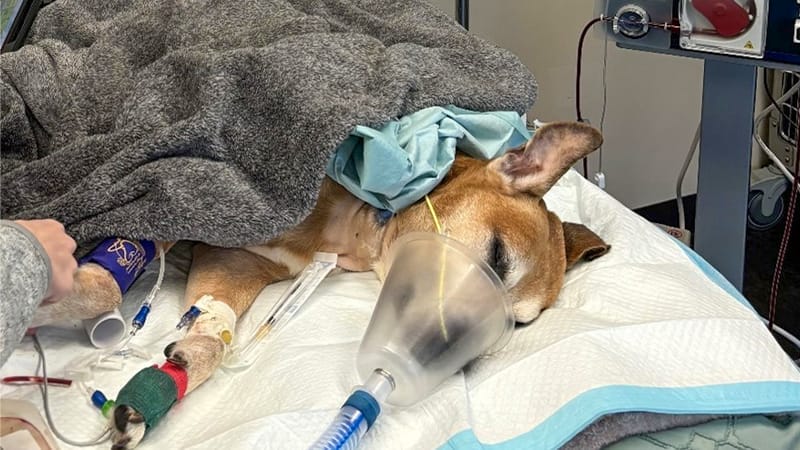What You Need to Know About Heatstroke in Dogs
Learn to prevent and spot signs of heatstroke in dogs, a deadly condition that damages internal systems.
Many of us look forward to playing with our pets outside in the warm weather – going for a run, tossing a ball for fetch, or basking in the sun. But warmer weather can also be dangerous for our companions who wear permanent fur coats, that’s why it’s important to know the signs of heatstroke in dogs and how you can prevent them.
How Do Dogs Cool Themselves?
Dogs have a fur coat and unlike humans, do not sweat through their skin (except for a small amount through their pads). That’s why they pant – panting cools their internal organs and helps regulate body temperature.
How Can Heatstroke Develop in Dogs?
Heatstroke occurs when the normal mechanisms cannot keep the body’s internal temperature within a safe range (dogs are normally 99-102.5 degrees). Causes may include:
- Being left in an unventilated area, such as a car – if the outside temperature is 90 degrees and the car windows are closed, the car’s temperature can rise to 109 degrees in under 10 minutes and to 119 degrees in 15 minutes. Even with the windows cracked (not fully open), a car at 84 degrees can rise to 98 degrees in just 10 minutes.
- Exercising strenuously, especially in hot, humid weather
- Being a brachycephalic dog, such as a Bulldog, Pug, or Pekinese – these breeds have short muzzles and often have pre-disposing respiratory issues, such as laryngeal collapse or tracheal collapse, that do not allow proper panting and breathing.
- Being overweight or possessing thick or dark fur
How Can Heatstroke in Dogs be Prevented?
To safeguard pets from heatstroke, it’s imperative to ensure their environment includes continuous access to fresh water, ample shade, and proper ventilation. For pets relocating to warmer climates, an acclimatization period of up to two months is essential for adapting to the heat.
Special attention is necessary for pets with cardiac or neurologic conditions, as they are more susceptible to the adverse effects of heat. By taking these precautions, you can help ensure the safety and wellbeing of your dog.

Signs of Heatstroke in Dogs
These early warning signs may indicate overheating and impending heatstroke:
- Continuous panting
- Dizziness, weakness, collapse or inability to walk
- Muscle tremors
- Dark red or pale gums
- Diarrhea
- Vomiting
- Increased heart rate
- Increased salivation or thick, sticky saliva
- Seeking cooler environments

What to Do if You Suspect Your Dog Has Heatstroke
Heatstroke is a medical emergency and it’s imperative to act swiftly if the above signs are observed. If you suspect your dog is showing signs of heatstroke, immediately take them to a cool, shady place. Cool the pet with room temperature water and move them to a shaded or air-conditioned area to help stabilize their body temperature. However, if signs persist for 10 to 15 minutes after initial cooling efforts, it is essential to immediately seek veterinary care from your family veterinarian or nearest MedVet.
How Heatstroke in Dogs is Treated
At MedVet, our dedicated emergency teams, supported by critical care specialists, are prepared to provide lifesaving treatment. When your pet arrives at our hospitals, we conduct thorough diagnostics to evaluate the initial impact to the pet’s body. Continuous monitoring is crucial, as signs can worsen even with optimal medical intervention.
Although services vary by location, our facilities are well-equipped to handle emergent medical issues, like heatstroke in dogs. We offer advanced ICU for continuous heart and blood pressure monitoring, and a range of support systems—from cages and oxygen-delivering nasal prongs to high-flow oxygen and mechanical ventilation for severe cases.
In the critical care of heatstroke pets, the initial stabilization phase is critical. Severe cases may lead to systemic inflammatory response, potentially causing progressive organ failure and abnormal blood clotting, also known as disseminated intravascular coagulation (DIC). Some MedVet locations offer a cutting-edge treatment called cytokine filtration*, only available at a select few institutions nationwide. Cytokine filtration utilizes a specialized blood filter to target the removal of inflammatory cytokines, certain bacterial toxins, and damage-associated pigments such as hemoglobin, myoglobin, and bilirubin. This innovative process supports organ recovery and offers a chance for survival, even to the most critically affected pets.
Treatment plans are tailored to meet the specific needs of each patient, ensuring the best possible chances for recovery.

Patient receives a continuous 24-hour session of cytokine filtration by the MedVet critical care team.
Prognosis for Dogs Who Have Heatstroke
The prognosis for a dog that has suffered from heatstroke depends on how quickly and effectively the treatment was administered. If caught early and treated promptly, many dogs can recover completely. However, severe cases can result in lasting damage to organs like the kidneys, liver, heart, and brain, or even death.
In conclusion, heatstroke is a preventable condition that requires awareness and proactive measures from dog owners. By understanding the causes, recognizing the signs, and knowing how to respond, you can ensure your dog enjoys a safe and healthy summer.
*Not all services are available in every hospital. Contact your local MedVet for services for that location.
FAQs
Learn More
For ways to ensure your pet lives a happier, healthier life, visit our Pet Care Resources library.
Pet Care ResourcesContents
Learn More
For ways to ensure your pet lives a happier, healthier life, visit our Pet Care Resources library.
Pet Care Resources

